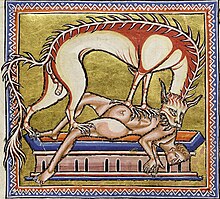| This article or section possibly contains synthesis of material that does not verifiably mention or relate to the main topic. Relevant discussion may be found on the talk page. (December 2012) (Learn how and when to remove this message) |

Werehyena is a neologism coined in analogy to werewolf for therianthropy involving hyenas. It is common in the folklore of the Arabian Peninsula, the Levant, North Africa, the Horn of Africa, and the Near East as well as some adjacent territories. Unlike werewolves and other therianthropes, which are usually portrayed as being originally human, some werehyena lore tells of how they can also be hyenas disguised as humans.
African cultures
In Somalia, it is traditionally believed that Qori Ismaris ("One who rubs himself with a stick") was a man who could transform himself into a "hyena-man" by rubbing himself with a magic stick at nightfall and by repeating this process could return to his human state before dawn.
In Ethiopia, it is traditionally believed that every blacksmith, whose trade is hereditary, is really a wizard or witch with the power to change into a hyena. These blacksmith werehyenas are believed to rob graves at midnight and are referred to as bouda (also spelled buda). They are viewed with suspicion by most countrymen. Belief in the bouda is also present in Sudan and Tanzania, as well as Morocco, where some Berbers regard them as a man or woman who nightly turns into a hyena and resumes human shape at dawn. Many Ethiopian Christians characterize Ethiopian Jews as being bouda, accusing them of unearthing Christian corpses and consuming them; the commonality of blacksmithing as a traditional profession for Jewish men in Ethiopia may be a reason for the connection between the two beliefs.
In the Kanuri language of the former Bornu Empire in the Lake Chad region, werehyenas are referred to as bultungin which translates into "I change myself into a hyena". It was once traditionally believed that one or two of the villages in the region was populated entirely by werehyenas, such as Kabultiloa. Any such person is called ngadza.
In the folklore of western Sudanic peoples, there is a hybrid creature, a human who is nightly transformed into a cannibalistic monster that terrorizes people, especially lovers. The creature is often portrayed as a magically powerful healer, blacksmith, or woodcutter in its human form, but recognizable through signs like a hairy body, red and gleaming eyes, and a nasal voice.
Members of the Korè cult of the Bambara people in Mali "become" hyenas by imitating the animals' behavior through masks and roleplay. These are evocative of the hyenas' reviled habits and may also be used to evoke fear among the participants, leading them to avoid such habits and traits in their own lives.
Other cultures
Al-Damiri, in his 1371 Ḥayāt al-ḥayawān al-kubrā, wrote that hyenas are vampiric creatures that attack people at night and suck the blood from their necks. Arab folklore tells of how hyenas can mesmerise victims with their eyes or sometimes with their pheromones.
A New Persian medical treatise written in 1376 tells how to cure people known as kaftar, who are said to be "half-man, half-hyena", who have the habit of slaughtering children.
The Greeks, until the end of the 19th century, believed that the bodies of werewolves, if not destroyed, would haunt battlefields as vampiric hyenas which drank the blood of dying soldiers.
Popular culture
| This section does not cite any sources. Please help improve this section by adding citations to reliable sources. Unsourced material may be challenged and removed. Find sources: "Werehyena" – news · newspapers · books · scholar · JSTOR (October 2022) (Learn how and when to remove this message) |
Werehyenas have appeared in popular culture:
- In DC Comics, Firestorm villain Hyena is an example of a werehyena; there have been different versions of this character.
- The Monsters episode "One Wolf's Family" features a werehyena named Stanley.
- The 1994 film The Heart's Cry features a werehyena.
- The Buffy the Vampire Slayer episode "The Pack" featured creatures similar to the werehyena.
- Ilona Andrews's Kate Daniels urban fantasy series features clan of werehyenas.
- The 2010 video game Cabela's Dangerous Hunts 2011 has a large hyena beast named the "Kaftar" as the final boss; the game heavily implies that the Kaftar is a werehyena.
- The 2011 film Hyenas featured some werehyenas.
- The 2021 fantasy novel Skin of the Sea by Natasha Bowen features werehyenas.
See also
References
- ^ Woodward, Ian (1979). The Werewolf Delusion. p. 256. ISBN 0-448-23170-0.
- Mohamed Diriye Abdullahi (2001). Culture and Customs of Somalia. Culture and Customs of Africa. Greenwood. p. 68. ISBN 9780313313332.
- ^ Tylor, Edward Burnett (1920). Primitive culture Vol. 1. John Murray. p. 310.
- ^ Salamon, Hagar (1999). The Hyena People: Ethiopian Jews in Christian Ethiopia. ISBN 0-520-21901-5.
- Massey, Gerald (2007). The Natural Genesis – Vol.1. Cosimo, Inc. p. 73. ISBN 978-1-60206-084-5.
- Koelle, Sigismund Wilhelm (1854). African Native Literature. p. 275. OL 24821270M.
- ^ "The Magicality of the Hyena: Beliefs and Practices in West and South Asia" (PDF). Asian Folklore Studies, Volume 57, 1998: 331–344. June 2008. Archived from the original (PDF) on 2008-06-25. Retrieved 23 June 2008.
- Mounir R. Abi-Said (2006). Reviled as a grave robber: The ecology and conservation of striped hyenas in the human-dominated landscapes of Lebanon.
External links
- Book Review: The Hyena People: Ethiopian Jews In Christian Ethiopia